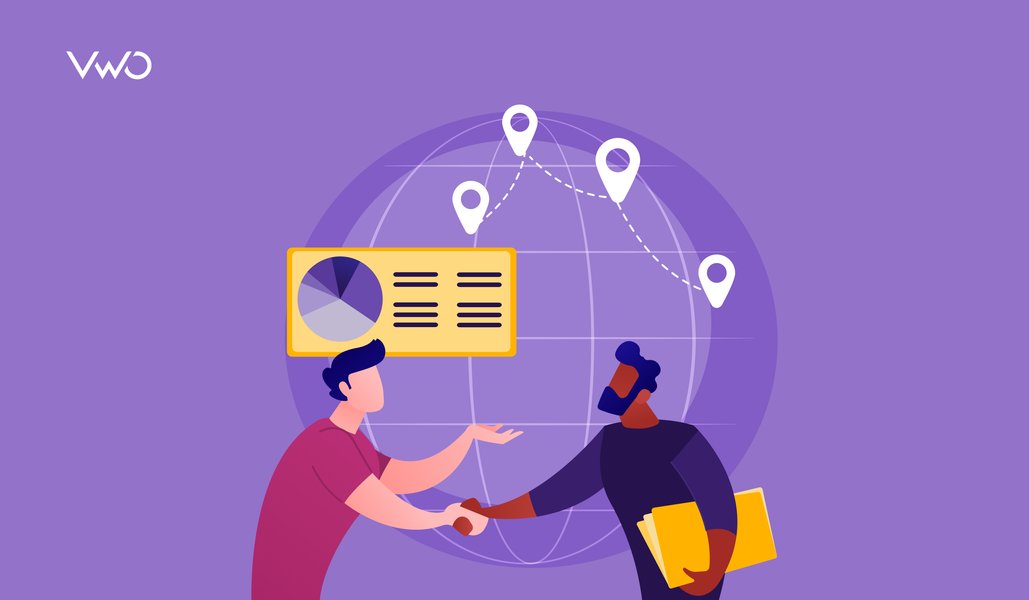Consumers in the digital age want an integrated shopping experience. They might browse an eCommerce website on mobile but ultimately make a purchase from desktop. Or they might pay online, but pick up the purchased item from the store.
Such user behavior has been highlighted by a 2014 GfK study: “With people constantly moving between devices, it is important for marketers to reach their audience across all platforms. Brand experiences should be consistent, allowing for people to begin an activity on one device and finish on another.”
Download Free: A/B Testing Guide
In this post, we discuss a robust omnichannel strategy that can help eCommerce enterprises create such integrated experiences across devices. The strategy includes:
- Understanding cross-device user behavior
- Crafting smooth shopping experiences across channels
- Forming organizational structures that support omnichannel
But before we begin, let’s see how an ideal omnichannel experience for a consumer, say “Sarah” would look like:
Sarah is checking Instagram from her mobile and likes a dress her friend is flaunting. She visits the retailer’s website on mobile. She adds the product to her “wishlist” on mobile. Later during the day, she accesses her wishlist on the desktop, with the decision to make a buy. She chooses the option “inform when available in my size” and 3 days later, gets an email notifying her about the availability of the dress. It also informs her that “click and collect” is available on the product. She decides to pick up the dress from a physical store.
So how do eCommerce enterprises go omnichannel successfully? Let’s talk about the three steps.
Tracking Cross-Device User Behavior
The fact that people toggle among multiple devices throughout the day makes understanding the cross-device user behavior an absolute essential for eCommerce enterprises. Traditional analytics tracking tools such as Google Analytics do not offer the scope for establishing a connect between users and their disparate gadgets. Cross-device tracking removes this barrier for eCommerce enterprises and enables them to understand their users’ behavior across all touchpoints.
Cross-device tracking allows enterprises to understand whether a person browsing a website from smartphone X is the same person who made the purchase from laptop Z. Such information is important to rectify conversion credit allocated disproportionately to the last device of purchase. So if the use of mobile devices leads to desktop purchases, eCommerce enterprises might want to spend more on mobile ads and mobile website optimization.
Deterministic Device Matching
This methodology makes use of user’s signin information. As users are required to sign in to the website on each device they use, enterprises can track their behavior across all touchpoints. User Authentication is a type of deterministic device matching. It uses specific identifiers such as a customer ID, signin information, and so on to study and form a link between user behavior across devices.
Probabilistic Device Matching
Unlike deterministic device matching, this cross-device tracking technique does not rely solely on the user’s signin information. As the name indicates, this method computes the probability that various devices belong to or have been used by the same individual. An example of how probabilistic device matching works is extrapolation. For example, if a mobile and a tablet use the same Internet connection, it can be extrapolated that they belong to the same household. Device Fingerprinting is another famous probabilistic cross-device tracking technique. It combines device settings and browser options with some other attributes such as WiFi info, IP address, and more to identify users.
Build Smooth Shopping Experiences Across Channels
The next step, after tracking and understanding user behavior across devices, is to create seamless experiences for your users.
 Walmart CEO, Doug McMillon shares his thoughts on a seamless customer experience:
Walmart CEO, Doug McMillon shares his thoughts on a seamless customer experience:
“Ultimately, customers don’t care about what channel they’re shopping in or about how we deliver them a product or service. They simply know they’re shopping with Walmart.”
For Walmart, no matter what channel their customers buy from, it is important that they recognize the brand and get the same shopping experience throughout. Creating cohesive, consistent brand voice/experience can help eCommerce enterprises pave trust and encourage strong engagement, and, therefore, improve sales.
Other than brand consistency, a smooth and seamless shopping experience also constitutes customer experience. Hubspot talks about Oasis, a UK fashion retailer, in their seven inspiring examples of omnichannel user experience. On entering one of their stores, you’ll find sales associates walk you through all the product-related information using iPads. So, just in case something is out of stock, the staff places an online order for the customer and the item is shipped directly to customer’s home.
eCommerce enterprises should focus on the following points for providing a superior omnichannel shopping experience:
- Providing relevant local information
- Ensuring faster, safer payment solutions
- Providing personalization
- Making use of advanced technologies
Providing relevant local information
A post on Think with Google reports that 75 percent of the shoppers who find local retail info in search results helpful are more likely to visit stores. For eCommerce enterprises, this data opens up a number of opportunities. For example, eCommerce enterprises can inform online customers looking for a particular item online about it’s availability at a nearby store. To make this activity more effective, they can use geo-targeting to drive more in-store purchases from people from the local vicinity who have an intent to buy. Moreover they can also provide information such as local store hours, directions to the local store, or any discounts running in the store. Providing local relevant information online can also help convert more of those shoppers who view shopping as an experience and not just a purchase activity. Retailers, on the other hand, can benefit from the impulse buying tendency of people who exhibit a search online, shop local behavior.
Ensuring faster, safer payment solutions
A Search Engine Journal post lists 10 popular online payment solutions such as Amazon Payments and Google Wallet. As these options are trustworthy and secure, these will encourage users to pay from any channel that they use.
Deploying these payment solutions is a win-win for both the parties, because these solutions are convenient, quick, and trustworthy.
Providing personalization
The interconnected and digitally empowered consumer demands relevant and personalized experience. For an omnichannel player, this would mean understanding which devices are used by the consumers and how. For example, Evergage talks about how eBay creates omnichannel personalization for its users. The eBay mobile app allows users to enable push notifications, which informs them about the start or end of any auction. The desktop site, on the other hand, is designed for easy search and window shopping.

Advanced technologies
Innovation and technology enhance the omnichannel experience both for buyers and eCommerce enterprises. Using virtual reality, for example, can help eCommerce players make use of virtual environments that are otherwise difficult to create inside a store. For the user, these technologies can address buyer’s uncertainty.
For example, before making a decision to buy a hat, a person would like to know which hat type, color, width, and so on would suit him the best. Without physically trying a number of different hats, he can use such technologies to find out what looks best on him. For the eCommerce enterprise, this means being able to provide their users with better services and experience even if all the types of hats are not physically in store.
Tommy Hilfiger also provides a fantastic in-store VR experience. As a result, shoppers can view virtual catwalks and shop the season’s runway styles.If you are looking for more on the who and how of virtual and augmented reality in retail and eCommerce, here’s a Forbes post to read.
Download Free: A/B Testing Guide
Forming an Organizational Structure that Supports Omnichannel
Customer experience might suffer if an eCommerce enterprise is not structured to meet the requirements of omnichannel retail. When departments operate in silos, the problem of sales attribution often arises. Such conflicts are unhealthy, as they can jeopardize the enterprise’s ability to deliver a smooth omnichannel experience.
An organizational structure that is better aligned for omnichannel, requires various departments within an organization to work together and be accountable to each other. Macy’s, for example, has also completely restructured their merchandising and marketing functions. They have also created chief omnichannel officer positions in their organization.

Keith Anderson, SVP Strategy & Insight, Profitero, suggests the following when it comes to creating supportive organizational structures for omnichannel.
“Here is the approach I suggest:
- Top-down commitment and support are essential. In the absence of the same, many organizations fail to prioritize or align on how to implement and execute on omnichannel.
- Key functions should be responsible, but the whole organization is accountable. Certain teams or titles should be primarily responsible for doing the work of marketing and selling through all channels. But the entire business should be accountable. There is a risk in simply appointing a “head of omnichannel,” without anticipating the impacts on other functions such as customer service, finance, and logistics. Digital and omnichannel competency is necessary for all company functions and disciplines, not just an isolated, specialist team.
- Definitions of success and incentives matter. Many companies that try to embrace omnichannel discover internal conflicts driven by misaligned incentives. For example, who gets the credit for an online sale fulfilled and collected in-store? How are inventory and labor costs allocated?
Ultimately, KPIs and incentives need to balance near-term and long-term goals such as maximizing profitability in the short-term versus growing market share. Also, enterprise success must always be prioritized over success in an isolated channel.”
Conclusion
While creating customer-centric experiences is the key to succeeding with omnichannel, it begins with understanding user behavior and extends to framing the right kind of organizational structures. There is a huge scope for eCommerce enterprises to adapt and excel at an omnichannel level, given that they make use of user information, technology, customer service, and their internal structures efficiently.
Over to You
Have feedback on how eCommerce enterprises can develop a robust omnichannel strategy? Reach out to us at marketing@vwo.com!





















